In C#, inheritance allows us to create a new class from an existing class. It is a key feature of Object-Oriented Programming (OOP).
The class from which a new class is created is known as the base class (parent or superclass). And, the new class is called derived class (child or subclass).
The derived class inherits the fields and methods of the base class. This helps with the code reusability in C#.
How to perform inheritance in C#?
In C#, we use the : symbol to perform inheritance. For example,
class Animal {
// fields and methods
}
// Dog inherits from Animal
class Dog : Animal {
// fields and methods of Animal
// fields and methods of Dog
}
Here, we are inheriting the derived class Dog from the base class Animal. The Dog class can now access the fields and methods of Animal class.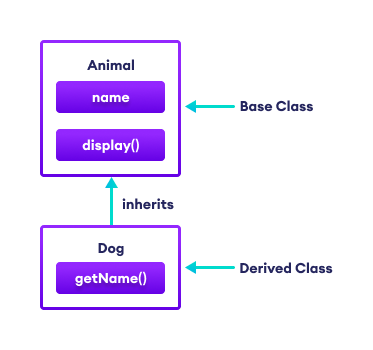
Example: C# Inheritance
using System;
namespace Inheritance {
// base class
class Animal {
public string name;
public void display() {
Console.WriteLine("I am an animal");
}
}
// derived class of Animal
class Dog : Animal {
public void getName() {
Console.WriteLine("My name is " + name);
}
}
class Program {
static void Main(string[] args) {
// object of derived class
Dog labrador = new Dog();
// access field and method of base class
labrador.name = "Rohu";
labrador.display();
// access method from own class
labrador.getName();
Console.ReadLine();
}
}
}
Output
I am an animal My name is Rohu
In the above example, we have derived a subclass Dog from the superclass Animal. Notice the statements,
labrador.name = "Rohu";
labrador.getName();
Here, we are using labrador (object of Dog) to access the name and display() of the Animal class. This is possible because the derived class inherits all fields and methods of the base class.
Also, we have accessed the name field inside the method of the Dog class.
is-a relationship
In C#, inheritance is an is-a relationship. We use inheritance only if there is an is-a relationship between two classes. For example,
- Dog is an Animal
- Apple is a Fruit
- Car is a Vehicle
We can derive Dog from Animal class. Similarly, Apple from Fruit class and Car from Vehicle class.
protected Members in C# Inheritance
When we declare a field or method as protected, it can only be accessed from the same class and its derived classes.
Example: protected Members in Inheritance
using System;
namespace Inheritance {
// base class
class Animal {
protected void eat() {
Console.WriteLine("I can eat");
}
}
// derived class of Animal
class Dog : Animal {
static void Main(string[] args) {
Dog labrador = new Dog();
// access protected method from base class
labrador.eat();
Console.ReadLine();
}
}
}
Output
I can eat
In the above example, we have created a class named Animal. The class includes a protected method eat().
We have derived the Dog class from the Animal class. Notice the statement,
labrador.eat();
Since the protected method can be accessed from derived classes, we are able to access the eat() method from the Dog class.
Types of inheritance
There are the following types of inheritance:
1. Single Inheritance
In single inheritance, a single derived class inherits from a single base class.
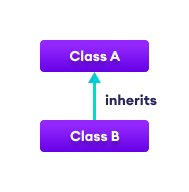
2. Multilevel Inheritance
In multilevel inheritance, a derived class inherits from a base and then the same derived class acts as a base class for another class.
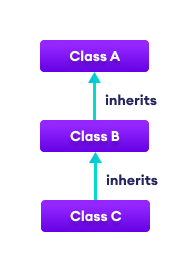
3. Hierarchical Inheritance
In hierarchical inheritance, multiple derived classes inherit from a single base class.
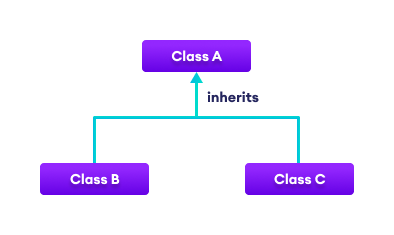
4. Multiple Inheritance
In multiple inheritance, a single derived class inherits from multiple base classes. C# doesn't support multiple inheritance. However, we can achieve multiple inheritance through interfaces.
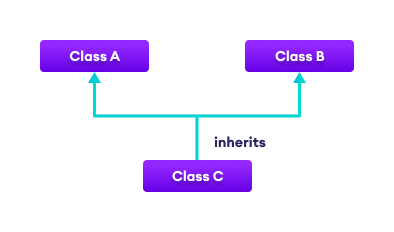
5. Hybrid Inheritance
Hybrid inheritance is a combination of two or more types of inheritance. The combination of multilevel and hierarchical inheritance is an example of Hybrid inheritance.
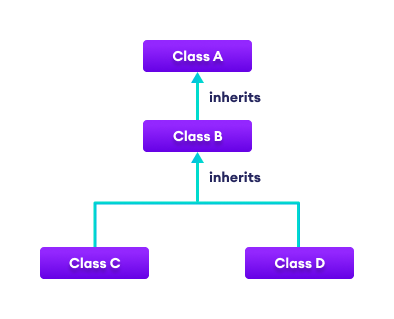
Method Overriding in C# Inheritance
If the same method is present in both the base class and the derived class, the method in the derived class overrides the method in the base class. This is called method overriding in C#. For example,
using System;
namespace Inheritance {
// base class
class Animal {
public virtual void eat() {
Console.WriteLine("I eat food");
}
}
// derived class of Animal
class Dog : Animal {
// overriding method from Animal
public override void eat() {
Console.WriteLine("I eat Dog food");
}
}
class Program {
static void Main(string[] args) {
// object of derived class
Dog labrador = new Dog();
// accesses overridden method
labrador.eat();
}
}
}
Output
I eat Dog food
In the above example, the eat() method is present in both the base class and derived class.
When we call eat() using the Dog object labrador,
labrador.eat();
the method inside Dog is called. This is because the method inside Dog overrides the same method inside Animal.
Notice, we have used virtual and override with methods of the base class and derived class respectively. Here,
virtual- allows the method to be overridden by the derived classoverride- indicates the method is overriding the method from the base class
base Keyword in C# Inheritance
In the previous example, we saw that the method in the derived class overrides the method in the base class.
However, what if we want to call the method of the base class as well?
In that case, we use the base keyword to call the method of the base class from the derived class.
Example: base keyword in C# inheritance
using System;
namespace Inheritance {
// base class
class Animal {
public virtual void eat() {
Console.WriteLine("Animals eat food.");
}
}
// derived class of Animal
class Dog : Animal {
// overriding method from Animal
public override void eat() {
// call method from Animal class
base.eat();
Console.WriteLine("Dogs eat Dog food.");
}
}
class Program {
static void Main(string[] args) {
Dog labrador = new Dog();
labrador.eat();
}
}
}
Output
Animals eat food. Dogs eat Dog food.
In the above example, the eat() method is present in both the base class Animal and the derived class Dog. Notice the statement,
base.eat();
Here, we have used the base keyword to access the method of Animal class from the Dog class.
Importance of Inheritance in C#
To understand the importance of Inheritance, let's consider a situation.
Suppose we are working with different types of vehicles such as cars and bicycles, and we need to calculate the speed of these vehicles based on given inputs of initial speed, acceleration, and time.
1. Since the formula to calculate speed is common for all vehicles, we can create a Vehicle class with a method calculateSpeed() to calculate speed.
class Vehicle
{
public void calculateSpeed()
{
// Code to compute speed
}
}
2. We then derive two classes: Car and Bicycle from the Vehicle class. These classes inherit the calculateSpeed() method from Vehicle but will have properties to store the initial speed, acceleration, and time because these are different for different vehicles.
class Car : Vehicle
{
public int initialSpeed = 0;
public double acceleration = 9.8;
public double time = 10;
}
We pass the value of initialSpeed, acceleration, and time to calculateSpeed() to compute the final speed.
This is how inheritance makes our code reusable and more intuitive.
Example: Importance of Inheritance
using System;
namespace Inheritance
{
// Base class for all vehicles
class Vehicle
{
// Method to calculate the speed after a given time
public void calculateSpeed(int initialSpeed, double acceleration, double time)
{
double finalSpeed = initialSpeed + acceleration * time;
Console.WriteLine("Final speed after " + time + " seconds is " + finalSpeed + " m/s.");
}
}
// Derived class for Cars
class Car : Vehicle
{
// Initial speed in m/s
public int initialSpeed = 0;
// Acceleration in m/s²
public double acceleration = 9.8;
// Time in seconds
public double time = 10;
public void displayCarDetails()
{
Console.WriteLine("Car is moving at an initial speed of " + initialSpeed + " m/s.");
}
}
// Derived class for Bicycles
class Bicycle : Vehicle
{
// Initial speed in m/s
public int initialSpeed = 5;
// Acceleration in m/s²
public double acceleration = 0.5;
// Time in seconds
public double time = 10;
public void displayBicycleDetails()
{
Console.WriteLine("Bicycle is moving at an initial speed of " + initialSpeed + " m/s.");
}
}
class Program
{
static void Main(string[] args)
{
Car myCar = new Car();
myCar.displayCarDetails();
myCar.calculateSpeed(myCar.initialSpeed, myCar.acceleration, myCar.time);
Bicycle myBicycle = new Bicycle();
myBicycle.displayBicycleDetails();
myBicycle.calculateSpeed(myBicycle.initialSpeed, myBicycle.acceleration, myBicycle.time);
}
}
}
Output
Car is moving at an initial speed of 0 m/s. Final speed after 10 seconds is 98 m/s. Bicycle is moving at an initial speed of 5 m/s. Final speed after 10 seconds is 10 m/s.
In the example above, we have created a Vehicle class that includes a method to calculate the speed of a vehicle after a given time based on its initial speed and acceleration.
Here, both Car and Bicycle inherit from the Vehicle class.
The formula to calculate speed is common for all vehicles, so we have reused the calculateSpeed() method of the base class.
And since the specifics of displaying vehicle details might differ for different vehicle types (such as a car or bicycle), we have created separate methods within the derived classes to display these details.